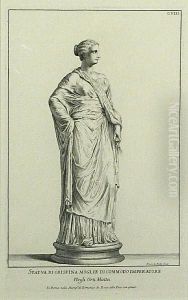Domenico De Rossi Paintings
Domenico De Rossi was an influential figure in the world of art and printmaking during the Baroque period. Born in 1659 in Rome, Italy, he was part of the Rossi family, a dynasty of printmakers and publishers who significantly contributed to the dissemination of artistic and architectural knowledge throughout Europe in the 17th and 18th centuries. Domenico took over the family business, the Rossi print shop (also known as La Stamperia Romana), from his father, Giovanni Giacomo De Rossi, who had established it as one of the most important and prolific print publishing enterprises of the time.
Domenico De Rossi's career was marked by his dedication to publishing large volumes of engravings, including works by and after famous artists and architects of the day. He is perhaps best remembered for his role in producing the 'Raccolta di statue antiche e moderne' (Collection of Ancient and Modern Statues), which was an extensive catalog of engravings of statues, both classical and contemporary. This work was instrumental in spreading the knowledge of classical art and aesthetics across Europe and contributed to the fervor for antique collections among the aristocracy and emerging bourgeoisie.
Under De Rossi's leadership, the family business flourished and expanded its catalog to include maps, topographical views, and architectural plans and elevations, thereby playing a crucial role in the documentation and dissemination of Baroque architecture and landscapes. His publications were essential for architects, artists, and scholars, who relied on them as visual resources and sources of inspiration.
Domenico De Rossi's impact extended beyond the confines of his print shop. He was at the center of the artistic and cultural milieu of Rome, collaborating with contemporary artists and architects to ensure that their works reached a wider audience. His contributions to the arts were not limited to his publications; he also supported artists directly and was involved in the artistic discourse of his time, thus playing a significant part in shaping the visual culture of the Baroque period.
De Rossi continued to lead his family's publishing house until his death in 1730. His legacy was not only the vast array of prints and books that bore his name but also his influence on the appreciation and study of classical art and architecture. Through his efforts, the Rossi print shop remained a pivotal institution in the European art world, setting high standards for quality and comprehensiveness in art publishing that would influence generations to come.
